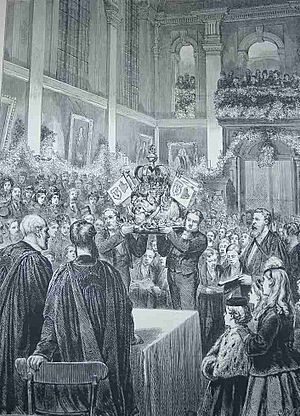Boar's Head Carol facts for kids
The Boar's Head Carol is a special English Christmas song from the 1400s. It's called "macaronic" because it mixes two languages: English and Latin. The song tells the story of an old tradition where a wild boar's head was brought to a big Christmas feast. The version of the song we usually hear today comes from a book published in 1521 called Christmasse Carolles.
Contents
History of the Boar's Head Tradition
The tradition of serving a boar's head likely started in Britain with the Anglo-Saxons a long time ago. We know most about it from the Middle Ages. In ancient Norse traditions, people would sacrifice a boar to ask the god Freyr for good luck in the new year. The boar's head, often with an apple in its mouth, would be carried into the feast hall with trumpets playing and minstrels singing.
In places like Scandinavia and England, Saint Stephen's Day, which is on December 26, became part of these winter celebrations. This day was previously linked to the old Norse traditions. In some old Swedish art, Saint Stephen is even shown looking after horses and bringing a boar's head to a Christmas feast. This shows how old customs blended with newer ones.
A famous scholar named Jacob Grimm also thought that serving a boar's head at feasts reminded people of an old Germanic custom. In this custom, a boar was sacrificed as part of the Yule celebration, which was a pagan winter festival.
Lyrics of the Carol
The Boar's Head Carol mixes English words with Latin phrases. Here are the lyrics:
The boar's head in hand bring I,
Bedeck'd with bays and rosemary.
And I pray you, my masters, be merry
Quot estis in convivio (Meaning: As many as are at the feast)
CHORUS
Caput apri defero (Meaning: The boar's head I bear)
Reddens laudes Domino (Meaning: Giving praises to the Lord)
The boar's head, as I understand,
Is the rarest dish in all this land,
Which thus bedeck'd with a gay garland
Let us servire cantico. (Meaning: Let us serve with a song)
CHORUS
Our steward hath provided this
In honour of the King of Bliss;
Which on this day to be servèd is
In Regimensi atrio. (Meaning: In the hall of The Queen’s [College, Oxford])
CHORUS
There is also another version of the song. Its words are changed to fit serving a bird instead of a boar. For example, "The boar's head in hand bring I" becomes "The fowl on the platter see."
Modern Celebrations
Today, the Boar's Head Carol and its traditions are still celebrated in a few places, especially around Christmas time.
England
- The Queen's College, Oxford: This college holds an annual "Boar’s Head Gaudy" which includes a special dinner. There's a fun old story from Oxford about this tradition. It says a student from the college was reading a book by Aristotle in a nearby forest when a wild boar attacked him. The brave student quickly shoved his book down the boar's throat, yelling "Græcum est!" (which means "It's Greek!"), and choked the boar with the book!
United States
- Asylum Hill Congregational Church, Hartford, Connecticut: This church has held a "Boar's Head and Yule Log Festival" every year since 1968.
- Christ Church Cathedral, Cincinnati, Ohio: This cathedral has also hosted a "Boar's Head and Yule Log Festival" since 1939.
- The College of Arts and Sciences at the University of Rochester in Rochester, New York: They have had a "Boar’s Head Dinner" since 1934.
- Christ Presbyterian Church in Ellwood City, Pennsylvania: This church has held a "Boar’s Head Festival" since 1982.
See also
- Boar's Head Inn


